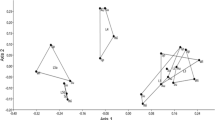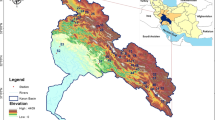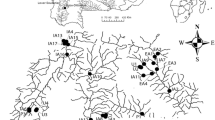Abstract
The increase of human activities in recent years has significantly interfered and affected aquatic ecosystems. In this present study, we investigate the effects of urbanization in the community structure of aquatic macroinvertebrates from Atlantic Forest streams. The sampling was conducted in the mountainous region of the State of Rio de Janeiro, Brazil in 10 urban and 10 preserved streams during the dry season (August–September) of 2012. The streams were characterized for its environmental integrity conditions and physico-chemical properties of water. The macroinvertebrates were sampled on rocky substrates with a kicknet. A total of 5370 individuals were collected from all streams and were distributed among Ephemeroptera, Odonata, Plecoptera, Hemiptera, Megaloptera, Coleoptera, Trichoptera, Lepidoptera, and Diptera. In urban sites, all those orders were found, except Megaloptera, while only Mollusca was not found in preserved streams. We performed a non-metric multidimensional scaling (NMDS) analysis that separated two groups distributed among sites in urban communities and another group outside this area. The dominance was significantly higher at urban sites, while the α diversity and equitability were greater in preserved sites. A canonical correspondence analysis (CCA) was also performed, indicating that most taxa associated with high values of the Habitat Integrity Index (HII) and a few genus of the order Diptera with the high values of ammonia, total nitrogen, associated to streams in urban sites. Urban and preserved streams differ by physical-chemical variables and aquatic macroinvertebrates. In urban streams, there is most dominance, while α diversity and equitability are higher in preserved streams.





Similar content being viewed by others
References
Allan, J. D. (1995). Stream ecology: structure and function of running waters (p. 388). London: Chapman and Hall.
Angrisano, E. B. (1995). Insecta trichoptera. In E. C. Lopretto & G. Tell (Eds.), Ecosistemas de aguas continentales. Metodologia para su estudio (3, pp. 1199–1224). La Plata: Ediciones Sur.
Azevedo, C. A. S. (2003). Taxonomia e bionomia de imaturos de megaloptera (insecta) na Amazônia Central, Brasil. Dissertação de mestrado (p. 183). Manaus: Instituto Nacional de Pesquisas da Amazônia/Universidade Federal o Amazonas.
Barbour, M.T., Gerritsen, J., Snyder B.D., Stribling J.B., (1999). Rapid bioassessment protocols for use in streams and Wadeable rivers: periphyton, benthic macroinvertebrates and fish. 2nd Edition. United States Environmental Protection Agency, EPA, 841-B-99-002, Washington DC.
Bojsen, B. H., & Jacobsen, D. (2003). Effects of deforestation on macroinvertebrate diversity and assemblage structure in Ecuadorian Amazon streams. Archiv fr Hydrobiologie, 158(3), 317–342.
Bonada, N., Prat, N., Resh, V. H., & Statzner, B. (2006). Developments in aquatic insect biomonitoring: a comparative analysis of recent approaches. Annu Rev Entomol, 51, 495–523.
Bower, C. E., & Holm-HANSEN, T. (1980). A salicylate-hypochlorite method for determining ammonia in seawater. Can J Fish Aquat Sci, 37, 794–798.
Boyero, L. (2000). Towards a global stream ecology. Trends Ecol Evol, 15, 390–391.
Bozelli, R. L., Caliman, A., Guariento, R. D., Carneiro, L. S., Santangelo, J. M., Barros, M. P. F., Leal, J. J. F., Rocha, A. M., Quesado, L. B., Lopes, P. M., Farjalla, V. F., Marinho, C. C., Roland, F., & Esteves, F. A. (2009). Interactive effects of environmental variability and human impacts on the long-term dynamics of an Amazonian floodplain lake and a South Atlantic coastal lagoon. Limnologica, 39, 306–313.
Brigante, J., & Espínola, E. L. G. (2003). Limnologia fluvial: um estudo no Rio mogi-guaçu. São Carlos: RiMA.
Bueno, A. A. P., Bond-Buckup, G., & Ferreira, B. D. P. (2003). Estrutura da comunidade de invertebrados aquáticos bentônicos em dois cursos d’água do Rio Grande do Sul. Revista Brasileira de Zoologia, 20(1), 115–125.
Buss, D. F., Baptista, D. F., Silveira, M. P., Nessimian, J. L., & Dorvillé, L. F. M. (2002). Influence of water chemistry and environmental degradation on macroinvertebrate assemblages in a river basin in southeast Brazil. Hydrobiologia, 481, 125–136.
Callisto, M., Moretti, M., & Goulart, M. (2001). Macroinvertebrados bentônicos como ferramenta para avaliar a saúde de riachos. Rev Bras Recur Hidr, 6(1), 71–82.
Camourze, J.P., (1994). O metabolismo dos ecossistemas aquáticos: fundamentos teóricos, métodos de estudo e análises. 1 ed. São Paulo, Editora Edgard, Blucher/Fapesp 253 pp.
Carlisle, D. M., & Clements, W. H. (2003). Growth and secondary production of aquatic insects along a gradient of Zn contamination in Rocky Mountain streams. J N Am Benthol Soc, 22, 582–597.
Carson, R.L., (1962). Silent Spring.Fawcett Publications, New York 304 pp.
Carvalho, A. L., & Calil, E. R. (2000). Chaves de identificação para as famílias de Odonata (Insecta) ocorrentes no Brasil, adultos e larvas. Papéis Avulsos de Zoologia, 41(15), 223–241.
Carvalho, A. L., Werneck-de-Carvalho, P., & Calil, E. R. (2002). Description of the larvae of two species of Dasythemis Karsch, with a key to the genera of Libellulidae occurring in the states of Rio de Janeiro and São Paulo, Brazil (Anisoptera). Odonatologica, 31(1), 23–33.
Cross, W. F., Wallace, J. B., Rosemond, A. D., & Eggert, S. L. (2006). Whole system nutrient enrichment increases secondary production in a detritus-based ecosystem. Ecology, 87, 1556–1565.
Cuffney, T. F., Wallace, J. B., & Lugthart, G. J. (1990). Experimental evidence quantifying the role of benthic invertebrates in organic matter dynamics of headwater streams. Freshw Biol, 23, 281–299.
Da-Silva, E. R., Salles, F. F., Nessimian, J. L., & Coelho, L. B. N. (2003). A identificação das famílias de Ephemeroptera (Insecta) ocorrentes no Estado do Rio de Janeiro: chave pictórica para as ninfas. Boletim do Museu Nacional Nova Série Zoológica, 508, 1–6.
Docile, T. N., & Figueiró, R. (2013). Histórico e perspectivas da utilização de macroinvertebrados no monitoramento biológico de ecossistemas aquáticos no brasil. Acta Scientiae et Technicae, 1, 31–44.
Dufrêne, M., & Legendre, P. (1997). Species assemblages and indicator species: the need for a flexible asymmetrical approach. Ecol Monogr, 67(3), 345–366.
Elliott, J.M., (1977). Some methods for the statistical analysis of samples of benthic invertebrates. Scientific Publication No .25, Freshwater Biological Association 157 pp.
Giller, P. S., & Malmqvist, B. (1998). The biology of streams and rivers (p. 296). New York: Oxford University Press.
Goulart, M. D., & Callisto, M. (2003). Bioindicadores de qualidade de água como ferramenta em estudos de impacto ambiental. Revista FAPAM, 2, 78–85.
Gulis, V., & Suberkropp, K. (2003). Leaf litter decomposition and microbial activity in nutrient-enriched and unaltered reaches of a headwater stream. Freshw Biol, 48, 123–134.
Hammer, O., Harper, D.A.T., Ryan, P.D., (2001). PAST - Palaeontological Statistics.
Heino, J., Muotka, T., & Paavola, R. (2003). Determinants of macroinvertebrate diversity in headwater streams: regional and local influences. J Anim Ecol, 72, 425–434.
Hynes, H. B. N. (1960). The biology of polluted waters (p. 202). Liverpool: Liverpool Univ. Press.
IBGE. Censo Demográfico (2010). Available in: https://www.censo2010.ibge.gov.br.
Lammert, M., & Allan, J. D. (1999). Assessing biotic integrity of streams: effects of scale in measuring the influence of land use/cover on habitat structure on fish and macroinvertebrates. Environ Manag, 23(2), 257–270.
Lemly, A. D. (1982). Modification of benthic insect communities in polluted streams: combined effects of sedimentation and nutrient enrichment. Hydrobiologia, 87, 229–245.
Lenat, D. R., & Crawford, J. K. (1994). Effects of land use on water quality and aquatic biota of three North Carolina Piedmont streams. Hydrobiologia, 294, 185–199.
Ludwig, J. A., & Reynolds, J. F. (1988). Statistical ecology: a primer on methods and computing. New York: John Wiley and Sons.
Mackereth, J. F. H., Heron, J., & Talling, J. F. (1978). Water analysis: some revised methods for limnologists. Freshwater Biol Assoc, 36, 121.
Mcallister, D. E., Hamilton, A. L., & Harvey, B. (1997). Global freshwater biodiversity: striving for the integrity of freshwater ecosystems. Sea Wind, 11(3), 1–142.
McClelland, W. T., & Brusven, M. A. (1980). Effects of sedimentation on the behaviour and distribution of riffle insects in a laboratory stream. Aquat Insects, 2, 161–169.
McCune, B., Mefford, M.J., (1999). Multivariate analysis of Ecological Data. Version 4.14. MJM Software, Gleneden Beach.
Merritt, R. W., & Cummins, K. W. (1996). Trophic relations of macroinvertebrates. In F. R. Hauer & G. A. Lamberti (Eds.), Methods in stream ecology (pp. 453–473). San Diego: Academic.
Moreno, J. L., Navarro, C., & Las Heras, J. D. (2006). Abiotic ecotypes in south central Spanish rivers: reference conditions and pollution. Environ Pollut, 143, 388–396.
Moriarty, C. (1990). European catches of elver 1928–1988. Int Rev Gesamten Hydrobiol, 75(6), 701–706.
Moulton, T. P., & Wantzen, K. M. (2006). Conservation of tropical streams—special questions or conventional paradigms? Aquat Conserv Mar Freshwat Ecosyst, 16, 659–663.
Nessimian, J. L., Venticinque, E. M., Zuanon, J., de Marco, P., Gordo, M., Fidelis, L., Batista, J. D., & Juen, L. (2008). Land use, habitat integrity and aquatic insect ssemblages in Central Aamazonian streams. Hydrobiologia, 614(1), 117–131.
Nusch, E. A., & Palme, G. (1975). Biologische methoden für die praxis der gewässeruntersuchung. Bestimmung des chlorophyll a und phaeopigmentgehaltes in oberflächenwasser. GWF-Wasser/Abwasser, 116, 562–565.
Okland, J., & Okland, K. A. (1980). Ph level and food organisms for fish: studies of 1000 lakes in Norway (pp. 326–327). Oslo: Ecological impact of acid precipitation.
Olifiers, M. H., Dorvillé, L. F. M., Nessimian, J. L., & Hamada, N. (2004). A key to Brazilian genera of plecoptera (Insecta) based on nymphs. Zootaxa, 651, 1–15.
Oliveira, L. G., & Froehlich, C. G. (1997). Diversity and community structure of aquatic insects (Ephemeroptera, Plecoptera and Trichoptera) in a mountain stream in Southeastern Brazil. Acta Limnologica Brasiliensia, 9, 139–148.
Ometto, J. P., Gessner, A., Martinelli, L. A., & Bernardes, M. C. (2004). Macroinvertebrate community as indicator of land-use changes in tropical watersheds, southern Brazil. Ecohydrol Hydrobiol, 4, 37–49.
O’Toole, C., Donohue, I., Moe, S. J., & Irvine, K. (2008). Nutrient optima and tolerances of benthic invertebrates, the effects of taxonomic resolution and testing of selected metrics in lakes using an extensive European data base. Aquat Ecol, 42, 277–291.
Passos, M. I. S., Nessimian, J. L., & Ferreira, J. R. (2007). Chaves para a identificação dos gêneros de Elmidae (Coleoptera) ocorrentes no Estado do Rio de Janeiro, Brasil. Revista Brasileira de Entomologia, 51(1), 42–53.
Paul, M. J., & Meyer, J. L. (2001). Streams in the urban landscape. Annu Rev Ecol Evol Syst, 32, 333–365.
Pes, A. M. O., Hamada, N., & Nessimian, J. L. (2005). Chaves de identificação de larvas para famílias e gêneros de Trichoptera (Insecta) da Amazônia Central, Brasil. Revista Brasileira Entomologia, 49(2), 181–204.
Petersen, R. C. J. R. (1992). The RCE: a riparian, channel, and environmental inventory for small streams in agricultural landscape. Freshw Biol, 27, 295–306.
Petruck, A., & Stöffler, U. (2011). On the history of chloride concentrations in the River Lippe (Germany) and the impact on the macroinvertebrates. Limnologica - Ecol Manag Inland Waters, 41, 143–150.
Plafkin, J.L., Barbour, M.T., Porter, K.D., Gross, S.K., Hughes, R.M., (1989). Rapid Bioassessment Protocols for Use in Streams and Rivers: Benthic Macroinvertebrates and Fish. United States Environmental Protection Agency, EPA, 444/4-89-001, Washington DC.
Ramírez, A., de Jesús-Crespo, R., Martinó-Cardona, D., Martínez Rivera, N., & Burgos-Caraballo, S. (2009). Urban streams in Puerto Rico: what can we learn from the tropics? J N Am Benthol Soc, 28, 1070–1079.
Reece, P.F., Richardson, J.S., (1999). Biomonitoring with the reference condition approach for the detection of aquatic ecosystems at risk. In: DARLING, L.M. Proc. Biology and Management of species and habitats at risk 2, 15–19
Resh, V., Rosenberg, D., (1984). The ecology of aquatic insects. Praeger 625 pp.
Rios, S. L., & Bailey, R. C. (2006). Relationship between riparian vegetation and stream benthic communities at three special scales. Hydrobiologia, 553, 153–160.
Roque, F. O., & Trivinho-Strixino, S. (2000). Fragmentação de habitas nos córregos do Parque Estadual do Jaraguá (SP): possíveis impactos na riqueza de macroinvertebrados e considerações para a conservação in situ (pp. 752–760). Campo Grande: Anais do II Congresso Brasileiro de Unidades de Conservação.
Roque, F. O., Trivinho-Strixino, S., Strixino, G., Agostinho, R. C., & Fogo, J. C. (2003). Benthic macroinvertebrate in streams of the Jaraguá State Park (Southeast of Brazil) considering multiple spatial scales. J Insect Conserv, 7, 63–72.
Salles, F.F., (2006). A ordem Ephemeroptera no Brasil (Insecta): taxonomia e diversidade. Ph.D. Thesis, Universidade Federal de Viçosa, Viçosa, MG, Brasil 300p.
Salomoni, S. E., Rocha, O., & Leite, E. H. (2007). Limnological characterization of Gravataí River, Rio Grande do Sul. Acta Limnologica Brasileinsia, 19, 1–14.
Shapiro, S.S., Wilk, M.B., (1965). Na analysis of variance test for normality: complete samples. Biometrika, London 52(¾):591–611.
Shepp, D. L., & Cummins, J. D. (1997). Restoration in an urban watershed: Anacostia river of Maryland and the district of Columbia. In J. E. Williams, C. A. Wood, & M. P. Dombeck (Eds.), Watershed restoration: principles and practices (pp. 297–317). Bethesda: American Fisheries Society.
Shieh, S. H., Ward, J. V., & Kondratieff, B. C. (2002). Energy flow through macroinvertebrates in a polluted plains stream. J N Am Benthol Soc, 21, 660–675.
Statsoft INC., (2004). STATISTICA (data analysis software system), version 7. www.statsoft.com.
Stewart, P. M., Butcher, J. T., & Swinford, T. O. (2000). Land use, habitat and water quality effects on macroinvertebrate communities in three watersheds of a Lake Michigan associated marsh system. Aquat Ecosyst Health Manag, 3, 179–189.
Ter Braak, C.J.F., Smilauer, P. (2002). CANOCO Reference manual and CanoDraw for Windows user’s guide: Software for Canonical Community Ordination (version 4.5). Ithaca, Microcomputer Power 500pp.
Thompson, R., & Townsend, C. (2000). Is resolution the solution? the effect of taxonomic resolution on the calculated properties of three stream food webs. Freshw Biol, 44, 413–422.
Vondracek, B., Blann, K. L., Cox, C. B., Nerbonne, J. F., Mumford, K. G., & Nerbonne, B. A. (2005). Land use, spatial scale, and stream systems: lessons from an agriculture region. Environ Manag, 36, 775–791.
Walsh, C. J., Roy, A. H., Feminella, J. W., Cottingham, P. D., Groffman, P. M., & MORGAN, R. P. (2005). The urban stream syndrome: current knowledge and the search for a cure. J N Am Benthol Soc, 24, 706–723.
Wenger, S. J., Roy, A. H., Jackson, C. R., Bernhardt, E. S., Carter, T. L., Filoso, S., Gibson, C. A., Hession, W. C., Kaushal, S. S., Martí, E., Meyer, J. L., Palmer, M. A., Paul, M. J., Purcell, A. H., Ramirez, A., Rosemond, A. D., Schofield, K. A., Sudduth, E. B., & Walsh, C. J. (2009). Twenty six key research questions in urban stream ecology: an assessment of the state of the science. J N Am Benthol Soc, 28, 1080–1098.
Wiggins, G. B. (1996). Larvae of the North America Caddisfly genera (Trichoptera) (2nd ed., p. 457). Toronto: University of Toronto Press.
Winemiller, K. O., & Jepsen, D. B. (1998). Effects of seasonality and fish movement on tropical river food webs. J Fish Biol, 53, 267–296.
Zar, J. H. (2009). Biostatical analysis. New Jersey: Prentice-Hall.
Acknowledgments
We would like to thank Larissa Duarte Correa and André Luiz Ramos da Silva (Laboratório de Entomologia, IB, UFRJ) for their help in field work, Mario Ribeiro and Claudio Marinho (Laboratório de Limnologia, IB, UFRJ) for their help with water analyses. To Instituto Brasileiro do Meio Ambiente e dos Recursos Naturais Renováveis (IBAMA), Instituto Chico Mendes de Conservação da Biodiversidade (ICMBio) and INEA for issuing collecting permits. Conselho Nacional de Desenvolvimento Científico e Tecnológico (CNPq) and Fundação Carlos Chagas Filho de Amparo à Pesquisa do Estado do Rio de Janeiro (FAPERJ) provided financial support by grants and fellowships.
Author information
Authors and Affiliations
Corresponding author
Electronic supplementary material
Below is the link to the electronic supplementary material.
ESM 1
(DOCX 80 kb)
Rights and permissions
About this article
Cite this article
Docile, T.N., Figueiró, R., Portela, C. et al. Macroinvertebrate diversity loss in urban streams from tropical forests. Environ Monit Assess 188, 237 (2016). https://doi.org/10.1007/s10661-016-5237-z
Received:
Accepted:
Published:
DOI: https://doi.org/10.1007/s10661-016-5237-z




